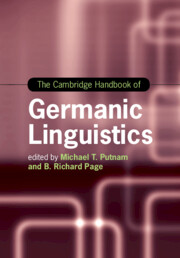Book contents
- The Cambridge Handbook of Germanic Linguistics
- Cambridge Handbooks in Language and Linguistics
- The Cambridge Handbook of Germanic Linguistics
- Copyright page
- Contents
- Figures
- Maps
- Tables
- Contributors
- Acknowledgments
- Germanic Languages
- Part I Phonology
- Part II Morphology and Agreement Systems
- Chapter 9 Verbal Inflectional Morphology in Germanic
- Chapter 10 Inflectional Morphology
- Chapter 11 Principles of Word Formation
- Chapter 12 Grammatical Gender in Modern Germanic Languages
- Chapter 13 Case in Germanic
- Chapter 14 Complementizer Agreement
- Part III Syntax
- Part IV Semantics and Pragmatics
- Part V Language Contact and Nonstandard Varieties
- Index
- References
Chapter 13 - Case in Germanic
from Part II - Morphology and Agreement Systems
Published online by Cambridge University Press: 31 March 2020
- The Cambridge Handbook of Germanic Linguistics
- Cambridge Handbooks in Language and Linguistics
- The Cambridge Handbook of Germanic Linguistics
- Copyright page
- Contents
- Figures
- Maps
- Tables
- Contributors
- Acknowledgments
- Germanic Languages
- Part I Phonology
- Part II Morphology and Agreement Systems
- Chapter 9 Verbal Inflectional Morphology in Germanic
- Chapter 10 Inflectional Morphology
- Chapter 11 Principles of Word Formation
- Chapter 12 Grammatical Gender in Modern Germanic Languages
- Chapter 13 Case in Germanic
- Chapter 14 Complementizer Agreement
- Part III Syntax
- Part IV Semantics and Pragmatics
- Part V Language Contact and Nonstandard Varieties
- Index
- References
Summary
This chapter provides a synchronic and diachronic overview of morphological case in the Germanic languages, as well as its relationship to phonology, syntax, and semantics. After some terminological and typological preliminaries, I begin with coverage of the different case inventories found in the various Germanic languages, laying out the relevant morphological details and the tracking the changes that effected the steady reductions in the systems across historical stages. I then move on to a description of how the cases in a given inventory are distributed across grammatical environments, and how this correlates with syntactic, semantic, and lexical factors. Finally, I tackle a series of empirical and theoretical questions surrounding the interactions of case with other grammatical phenomena, which are of general cross-linguistic interest, but where the Germanic languages have played an especially important role in the literature. These include how cases relate to grammatical functions, the status of apparent oblique subjects and `quirky case‘, and more broadly what case phenomena might tell us about how morphology interfaces with syntax.
Keywords
- Type
- Chapter
- Information
- The Cambridge Handbook of Germanic Linguistics , pp. 282 - 312Publisher: Cambridge University PressPrint publication year: 2020



